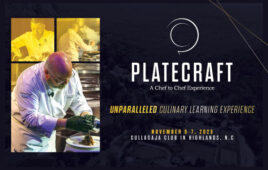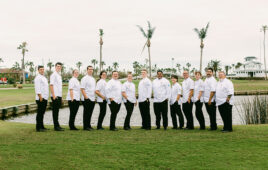 J. Kevin Walker, CMC
|
Fourth of July picnics with over 2.600 attendees are just another meal occasion for J. Kevin Walker, CMC, Executive Chef at Atlanta’s Cherokee Town and Country Club.
Cherokee Town and Country Club started as an Atlanta social club in 1956. The club now has two locations: the Town Club, which occupies the famed Grant Estate in Atlanta’s Buckhead section, and the Country Club, a bit farther out near the Chattahoochee River in Sandy Springs.
From the start, there has never been anything small about foodservice at Cherokee, which now has six kitchens and eight F&B outlets between its two venues. Early on, club activities centered around large gatherings held before and after local sporting events, and these remain an immensely popular part of the Cherokee calendar and cultur
Even with this kind of volume, Cherokee has been known since its inception for exceptional member and dining services. The club has earned numerous national awards over the years, including status as “America’s Very Best Private Club,” and the 2004 American Culinary Federation’s Commitment to Excellence Award for Outstanding Dining in the Private Club Sector.
Cherokee’s current Executive Chef, J. Kevin Walker, CMC, is one of only 70 certified master chefs in America. He came to Cherokee in 2002 with vast experience in the industry (see box at left) and immediately began to lead the club to new culinary levels—including directing the F&B program through a major renovation of the Town Club kit
C&RB appreciates having such an accomplished chef provide a peek behind the growth and success of a prestigious club culinary operation, and also sharing his thoughts about where our industry stands today.
Q Chef, Cherokee has a tremendous food and beverage reputation. How do you challenge yourself and your team to raise the bar every season?
A I am very lucky. I have a very passionate and incredibly talented staff. We are constantly asking each other “What if?” and “How can we?” No question is considered out of bounds, and everyone’s input is welcomed. The staff knows, and embraces, this approach. With this type of atmosphere, everyone feels comfortable speaking their mind
Q With six kitchens and eight outlets, how do you mesh menus, save labor and stay consistent?
A Simple things are the key, like having one person in charge of making soups and then cross-utilizing them from banquet menus for that day, as the soup du jour. The Garde Manger makes chicken salad for the Town Club, while our Grant Pub kitchen makes all the tuna salad. It helps to lighten everyone’s load and maintain the consistency.
We build daily buffets around daily functions. We make sure all trim and byproducts are used in the creation of specials. Also, we have certain Sous Chefs in charge of ordering key items. For example, my Executive Sous Chef orders all seafood, so any seafood order must go through him. This allows us to make sure we are not over-ordering
Since we have two facilities, transferring staff between kitchens ensures that quality levels remain constant throughout the club. Also, having complete buy-in from all of the Sous Chefs and Lead Line Cooks is key, which goes back to inviting their feedback and input. When someone brings an idea to the table, it is discussed and vetted out. If a better way to approach the situation is found, it is adopted by all and becomes the new Standard Operating Procedure.
Q What are the food trends that currently stand out to you in the club industry specifically?
A Because of the exclusive nature of clubs, the flexibility in costs gives the chef the opportunity to experiment with items that aren’t always as available or cost-effective for a free-standing establishment. This is one of the greatest advantages of working in a club. The membership is really the only “barrier” to our imagination. But through good communication and education, this “obstacle” can easily be conquered.
We are seeing a great push towards more sustainable and locally produced products, which is wonderful news for local economies. Becoming green, using organic ingredients, slow cooking, sugar-free baking, and expanding menu offerings with underutilized cuts of proteins are a few of the trends I see on the horizon—not only for all clubs,
Q Cherokee is going through some extensive renovations, and the temporary effect on sales stands to be dramatic. What is the projected impact on business levels and on your payroll?
A As much as we have been able to maintain business in our formal dining areas, our casual areas are booming. So through our strategic “Plan for Progress,” we are allocating capital to respond to the demographic and usage changes we see taking place over time. In expanding our casual dining areas and associated kitchen, we know that the costs of running them will increase. But because Cherokee members use the club as if it were their second home, we anticipate those added costs will be more than offset by higher utilization, both in private dining as well as the expanded adult casual and outdoor dining areas.
Given this long-term outlook, the Board and management have worked hard to try to minimize the short-term pain. When the foodservice shutdown arrives next May, all full-time employees will have a job of some sort, and will be paid their salaries based on average hours for the same timeframe from 2008.
We have pledged to our membership that we will operate at 100% and as if nothing is going on. We are working very hard to ensure that when they walk through the front door, their experience will not be any different than before the construction started.
Q Your operations are 95% scratch. Does this make it more difficult to operate “as normal” during such a project? How does it affect areas like baking and your overall food cost percentage?
A Pastry was only affected on a limited basis for a two-week period while we were moving the shop to its temporary location, which after the renovation will be a banquet warming kitchen. We are supplementing some bread items with frozen products, but we believe the key to this is picking items that we can still identify ourselves with an be proud to serve. That is always the key: Whatever we serve we must be proud of, as if it came from our kitchen.
I think our food cost issues are no different than what any other foodservice establishment is having this year. Everything is costing more, not just center-of-the-plate items. That makes all production costs skyrocket, and causes us to have to be more creative with everything we do. But again, sacrificing quality is not an option.




